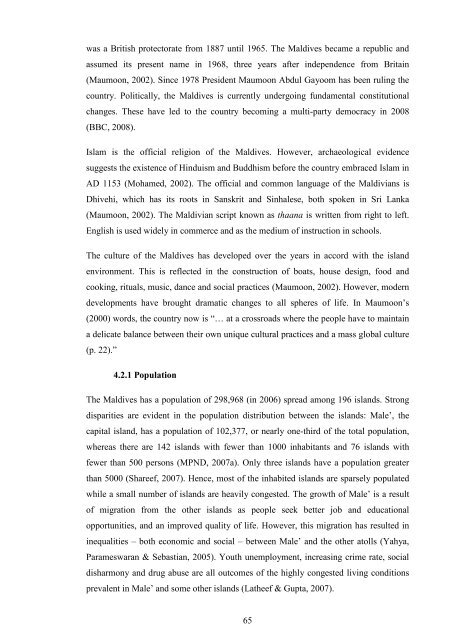The Role of Local Food in Maldives Tourism - Scholarly Commons ...
The Role of Local Food in Maldives Tourism - Scholarly Commons ...
The Role of Local Food in Maldives Tourism - Scholarly Commons ...
You also want an ePaper? Increase the reach of your titles
YUMPU automatically turns print PDFs into web optimized ePapers that Google loves.
was a British protectorate from 1887 until 1965. <strong>The</strong> <strong>Maldives</strong> became a republic and<br />
assumed its present name <strong>in</strong> 1968, three years after <strong>in</strong>dependence from Brita<strong>in</strong><br />
(Maumoon, 2002). S<strong>in</strong>ce 1978 President Maumoon Abdul Gayoom has been rul<strong>in</strong>g the<br />
country. Politically, the <strong>Maldives</strong> is currently undergo<strong>in</strong>g fundamental constitutional<br />
changes. <strong>The</strong>se have led to the country becom<strong>in</strong>g a multi-party democracy <strong>in</strong> 2008<br />
(BBC, 2008).<br />
Islam is the <strong>of</strong>ficial religion <strong>of</strong> the <strong>Maldives</strong>. However, archaeological evidence<br />
suggests the existence <strong>of</strong> H<strong>in</strong>duism and Buddhism before the country embraced Islam <strong>in</strong><br />
AD 1153 (Mohamed, 2002). <strong>The</strong> <strong>of</strong>ficial and common language <strong>of</strong> the Maldivians is<br />
Dhivehi, which has its roots <strong>in</strong> Sanskrit and S<strong>in</strong>halese, both spoken <strong>in</strong> Sri Lanka<br />
(Maumoon, 2002). <strong>The</strong> Maldivian script known as thaana is written from right to left.<br />
English is used widely <strong>in</strong> commerce and as the medium <strong>of</strong> <strong>in</strong>struction <strong>in</strong> schools.<br />
<strong>The</strong> culture <strong>of</strong> the <strong>Maldives</strong> has developed over the years <strong>in</strong> accord with the island<br />
environment. This is reflected <strong>in</strong> the construction <strong>of</strong> boats, house design, food and<br />
cook<strong>in</strong>g, rituals, music, dance and social practices (Maumoon, 2002). However, modern<br />
developments have brought dramatic changes to all spheres <strong>of</strong> life. In Maumoon’s<br />
(2000) words, the country now is “… at a crossroads where the people have to ma<strong>in</strong>ta<strong>in</strong><br />
a delicate balance between their own unique cultural practices and a mass global culture<br />
(p. 22).”<br />
4.2.1 Population<br />
<strong>The</strong> <strong>Maldives</strong> has a population <strong>of</strong> 298,968 (<strong>in</strong> 2006) spread among 196 islands. Strong<br />
disparities are evident <strong>in</strong> the population distribution between the islands: Male’, the<br />
capital island, has a population <strong>of</strong> 102,377, or nearly one-third <strong>of</strong> the total population,<br />
whereas there are 142 islands with fewer than 1000 <strong>in</strong>habitants and 76 islands with<br />
fewer than 500 persons (MPND, 2007a). Only three islands have a population greater<br />
than 5000 (Shareef, 2007). Hence, most <strong>of</strong> the <strong>in</strong>habited islands are sparsely populated<br />
while a small number <strong>of</strong> islands are heavily congested. <strong>The</strong> growth <strong>of</strong> Male’ is a result<br />
<strong>of</strong> migration from the other islands as people seek better job and educational<br />
opportunities, and an improved quality <strong>of</strong> life. However, this migration has resulted <strong>in</strong><br />
<strong>in</strong>equalities – both economic and social – between Male’ and the other atolls (Yahya,<br />
Parameswaran & Sebastian, 2005). Youth unemployment, <strong>in</strong>creas<strong>in</strong>g crime rate, social<br />
disharmony and drug abuse are all outcomes <strong>of</strong> the highly congested liv<strong>in</strong>g conditions<br />
prevalent <strong>in</strong> Male’ and some other islands (Latheef & Gupta, 2007).<br />
65

















